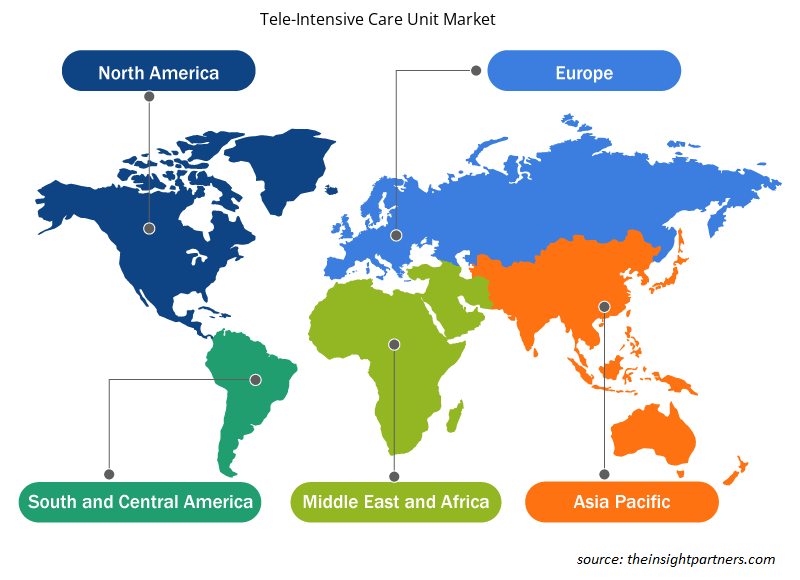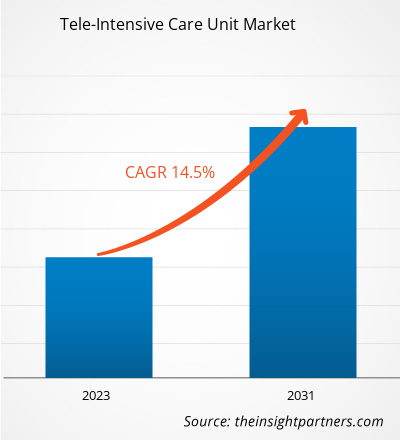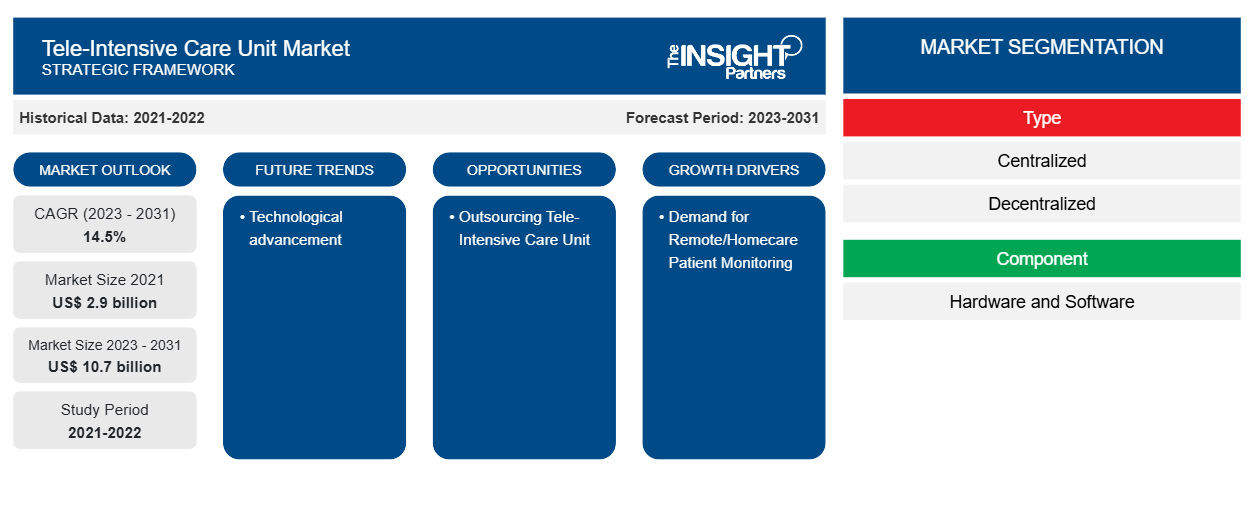2021 年远程重症监护病房市场价值为 29 亿美元,预计到 2031 年将达到 107 亿美元。预计 2023 年至 2031 年期间该市场的复合年增长率为 14.5%。
医疗机构中技术与医疗保健的不断融合可能仍将成为远程重症监护病房市场的一个关键趋势。
远程重症监护病房市场分析
远程/家庭护理患者监护需求
结合远程重症监护病房可提高医院的整体容量和吞吐量,这些医院的入院率、再入院率和远程治疗服务水平较低。此外,远程重症监护病房能够缩短住院时间 (LOS),因此医院可以通过在维持相同数量的重症监护病床和相关重症监护病房人员成本的情况下接收更多患者,从而提高容量和吞吐量。由于医生和护士严重短缺,医院面临着实现更好健康结果的巨大压力。为了解决这个问题,各种研究/调查显示,远程重症监护病房可以帮助卫生系统改善运营,让更多患者在低容量社区医院重症监护病房接受治疗,而不是转移到高成本和高容量的三级医院/中心。例如,与大型学术医疗中心 (AMC) 相比,在入住率较低的社区医院安装远程重症监护病房,可以通过在其社区重症监护病房设施中留住更多患者、增加收入周期管理 (RCM) 和增强医疗保健服务的可持续性而受益。上述因素是远程重症监护病房市场增长的重要原因。
远程重症监护病房市场概况
技术、创新和智能技术解决方案继续对远程重症监护室产生重大影响。对远程/家庭护理患者监控的需求以及通过远程重症监护室实现高效的医院结果是远程重症监护室市场增长的最重要因素。技术进步是远程重症监护室市场增长的关键趋势。外包远程重症监护室将提供有利可图的市场机会。
定制此报告以满足您的需求
您可以免费定制任何报告,包括本报告的部分内容、国家级分析、Excel 数据包,以及为初创企业和大学提供优惠和折扣
-
获取此报告的关键市场趋势。这个免费样品将包括数据分析,从市场趋势到估计和预测。
远程重症监护病房市场驱动因素和机遇
通过远程重症监护病房实现高效的医院治疗效果,有利于市场
根据荷兰皇家飞利浦公司报告发布的统计数据,一项在医院进行的为期 5 年的研究表明,远程重症监护病房对 56 个重症监护病房、32 家医院和 19 个简化医疗系统的 188,990 名重症监护患者产生了影响,导致患者死亡率和住院时间 (LOS) 减少。此外,荷兰皇家飞利浦公司报告发布的另一项研究显示,远程重症监护病房将医疗事故索赔减少了近 90%。
因此,在未来几年,减少医疗事故索赔、降低死亡率和快速住院患者出院等方面的高效医院成果将为远程 ICU 市场做出重大贡献。
外包远程重症监护病房——一个机会
对于低容量医疗单位或医院(ICU 床位容量少于 50 张),可能无法通过内部设施实施完整的企业远程 ICU。因此,小型医疗单位或医院可以与顶级远程 ICU 服务提供商合作。例如,飞利浦企业远程 ICU 服务的模块化方法使低容量医疗单位或医院能够使用高效的实施计划扩大/采购大型 ICU 床位。例如,飞利浦“eICU 外展计划”通过以最少的投资建立合作伙伴关系,方便访问从小型到大型的重症监护病房或医院。因此,小型重症监护病房或医院采用外包远程 ICU 服务将为远程重症监护病房市场提供丰厚的市场机会,在未来几年占据相当大的市场份额。
远程重症监护病房市场报告细分分析
远程重症监护病房市场分析的关键部分是候选人资格和服务。
- 根据类型,市场分为集中式、分散式和其他类型。集中式部分可能会在 2023 年占据更大的市场份额。
- 按组件划分,市场分为硬件和软件。硬件部分可能在 2023 年占据最大的市场份额。
远程重症监护病房市场份额按地区分析
远程重症监护病房市场报告的地理范围主要分为五个地区:北美、亚太、欧洲、中东和非洲、南美/南美和中美。
北美主导着远程重症监护病房市场。在北美,美国在远程重症监护病房市场占有相当大的份额。美国顶级医疗器械公司的存在、产品创新和技术先进的产品是推动市场增长的最重要因素。预计亚太地区未来几年将以最高的复合年增长率增长。
远程重症监护病房市场区域洞察
Insight Partners 的分析师已详尽解释了预测期内影响远程重症监护病房市场的区域趋势和因素。本节还讨论了北美、欧洲、亚太地区、中东和非洲以及南美和中美洲的远程重症监护病房市场细分和地理位置。

- 获取远程重症监护病房市场的区域特定数据
远程重症监护病房市场报告范围
| 报告属性 | 细节 |
|---|---|
| 2021 年市场规模 | 29亿美元 |
| 2031 年市场规模 | 107亿美元 |
| 全球复合年增长率(2023 - 2031) | 14.5% |
| 史料 | 2021-2022 |
| 预测期 | 2023-2031 |
| 涵盖的领域 |
按类型
|
| 覆盖地区和国家 |
北美
|
| 市场领导者和主要公司简介 |
|
远程重症监护病房市场参与者密度:了解其对业务动态的影响
远程重症监护室市场正在快速增长,这得益于终端用户需求的不断增长,这些需求源于消费者偏好的不断变化、技术进步以及对产品优势的认识不断提高等因素。随着需求的增加,企业正在扩大其产品范围,进行创新以满足消费者的需求,并利用新兴趋势,从而进一步推动市场增长。
市场参与者密度是指在特定市场或行业内运营的企业或公司的分布情况。它表明在给定市场空间中,相对于其规模或总市场价值,有多少竞争对手(市场参与者)存在。
在远程重症监护病房市场运营的主要公司有:
- InTouch 技术公司
- 高级ICU护理
- 荷兰皇家飞利浦公司
- Ceiba-TeleICU
- 旗帜健康
- 远程ICU护理
免责声明:上面列出的公司没有按照任何特定顺序排列。

- 获取远程重症监护病房市场顶级关键参与者概览
远程重症监护病房市场新闻和最新发展
远程重症监护病房市场通过收集初级和二级研究后的定性和定量数据进行评估,其中包括重要的公司出版物、协会数据和数据库。以下是远程重症监护病房市场的发展和战略列表:
- 2023 年 7 月,Medanta(医院集团)宣布与 GE Healthcare 合作在印度推出远程重症监护室服务,即“Medanta e-ICU 项目”。eICU 平台将提供近乎实时的患者监控,即使在午夜等非正常时段也能实现,从而实现早期患者干预。
远程重症监护病房市场报告覆盖范围和交付成果
“远程重症监护病房市场规模和预测(2021-2031)”报告对以下领域进行了详细的市场分析:
- 范围内涵盖的所有主要细分市场的全球、区域和国家层面的市场规模和预测
- 市场动态,如驱动因素、限制因素和关键机遇
- 未来主要趋势
- 详细的 PEST/波特五力分析和 SWOT 分析
- 全球和区域市场分析涵盖关键市场趋势、主要参与者、法规和最新市场发展
- 行业格局和竞争分析,涵盖市场集中度、热点图分析、知名参与者和最新发展
- 详细的公司简介
- 历史分析(2 年)、基准年、预测(7 年)及复合年增长率
- PEST和SWOT分析
- 市场规模、价值/数量 - 全球、区域、国家
- 行业和竞争格局
- Excel 数据集
近期报告
客户评价
购买理由
- 明智的决策
- 了解市场动态
- 竞争分析
- 客户洞察
- 市场预测
- 风险规避
- 战略规划
- 投资论证
- 识别新兴市场
- 优化营销策略
- 提升运营效率
- 顺应监管趋势























 获取免费样品 - 远程重症监护病房市场
获取免费样品 - 远程重症监护病房市场